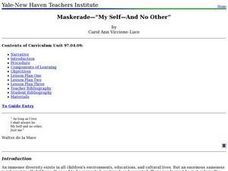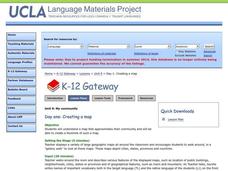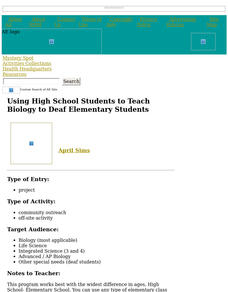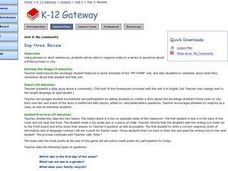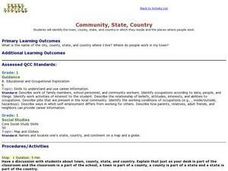Curated OER
The Built Environment-An Integrating Theme
Students observe, record, and present knowledge of their local built environment while conducting a walking tour of their community. They develop written and photo journals, drawings, time lines, graphs, and charts to engage in...
Curated OER
Ecology Lessons
Students examine the relationship between animal adaptations, habitats and community interactions. In this ecology lesson plan students complete a skull detective worksheet then use their knowledge to analyze a skull.
Curated OER
Maskerade, My Self, And No Other
Students examine themselves, discover their strong, positive attributes, and recognize areas in need of improvement (since each individual possesses strengths but all people have some weaknesses). They develop self-acceptance, trust in...
Curated OER
Castle/Fort Unit
Students compare and contrast castles and forts. They observe buildings in their community and consider how castles and forts are similar. They design their own castle or fort and brainstorm materials to build with, discuss how the...
Facing History and Ourselves
How Do Communities Define We and They?
Learners consider the categorization of people. For this community identity instructional activity, 6th graders examine community membership definitions and consider how those outside of the group view themselves. Learners analyze The...
Curated OER
Service Learning
Students view video clips to define service learning. In this civics lesson, students read quotes, take a survey, and define altruism. Students view video clips and evaluate the motivation and impact of those who perform community...
Curated OER
Survival Kit
Students discuss how a strong community can be helpful for survival during hard times. In this Survival Kit art activity, students create their own Survival Kit. Students use various items to symbolize things needed for survival in day...
Curated OER
Helping Hands
Students discuss what they can do to help their community, then create posters for the school that list and provide details for 'Ten Things You Can Do To Help' in different social service areas.
Curated OER
Nunavut, Our Communities
Students locate the communities of Nanavut on a territorial map and identify community characteristics. They research the online Atlas of Canada
Facing History and Ourselves
Eyes on the Prize Lesson 1: The Philosophy of Nonviolence
Students explore the concept of nonviolent demonstration. In this Civil Rights Movement activity, students investigate examples of injustice and discuss the philosophy of nonviolence fueled by leaders of the movement. Students apply...
Curated OER
Around Town
Students explore their community. In this picture taking lesson, students visit different places in the community. Students take pictures at each place they visit. Students use adjectives to describe the pictures they took and write them...
Curated OER
Classroom Guide for Saturday At The New You
Students complete guided reading activities for the book, Saturday At The New You I by Barbara e. Barber. They read about a young girl who visits her mother's beauty salon on Saturdays. They answer pre-reading questions and decide...
Curated OER
Kinds of Communities: Write On Grade 3
This PowerPoint includes text describing the key elements of a community, as well as the unique features of a suburb, a city, and a town. Illustrations and clip art are included depicting each type of community. Instructions for...
Curated OER
How About a Hand?
Students experience a shared reading regarding the importance of feeling like a valued member of the community within a family. In this family member feelings lesson, students discuss the feelings and the motives of the characters....
Curated OER
Peace Calendar
Students discover ways to make the world a peaceful place. In this humanity lesson, students read the book Peace Begins with You by Katerine Sholes, then discuss how they can have a peaceful impact on their society. Students...
Curated OER
Creating a Map
Students create a map of their community. In this mapping instructional activity, students identify various geographical features and the cardinal directions on maps displayed in the classroom. Students are divided into three groups to...
Curated OER
Our Town
Students read and discuss an online article as they consider what makes a center of activity in a city or town. They produce a documentary film of the hub of activity in their school.
Curated OER
Using High School Students to Teach Biology to Deaf Elementary Students
Learners teach Biology concepts to elementary students, in particular deaf learners, by traveling once a month to the elementary classroom with activities / lessons that have been selected and prepared by the older students.
Curated OER
Getting Caught In The Web
Sixth graders brainstorm the ways a person's actions can affect a community. As a class, one classmate is given a ball of yarn and pass it along to another student creating a web. Next, some classmates are asked to drop their part and...
Curated OER
Willie the Worm
Students explore Earth science by participating in a compost activity in class. For this worm lesson, students discuss the importance of worms in the creation of plants. Students cut out pieces from a print out to assemble a paper worm...
Curated OER
Review of My Community
Young scholars review activities from the "My Home" unit. In this review lesson, students view a PowerPoint about a community then play a game to answer a variety of questions about the community. PowerPoint may be in English or...
Curated OER
Women's Role in the Mi'kmaq Community Long Ago
Fifth graders examine the responsibilities that the Mi'kmaq women had prior to the arrival of the Europeans. They examine artwork by Robert Harris, design and create a talking stick, demonstrate a talking circle, and write journal...
Curated OER
The Changing Coral Reef Community Game
Learners examine organisms that inhabit the coral reefs and their living requirements. In this coral reef lesson students chart population changes and play a game.
Curated OER
Community, State, Country
First graders identify the town, county, state, and country in which they reside and the places where people work. They draw a picture of one of the places where people work.




